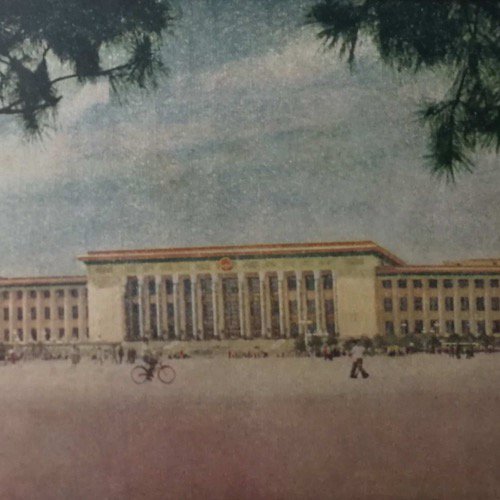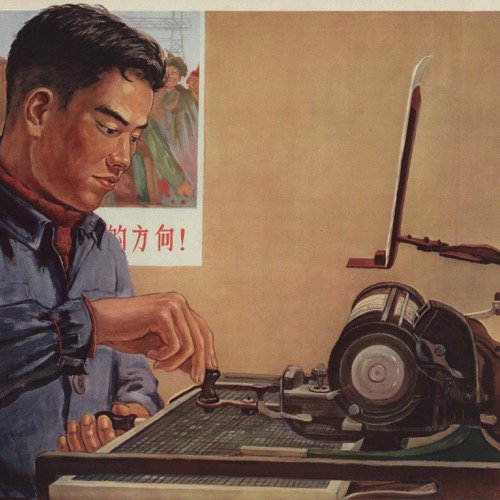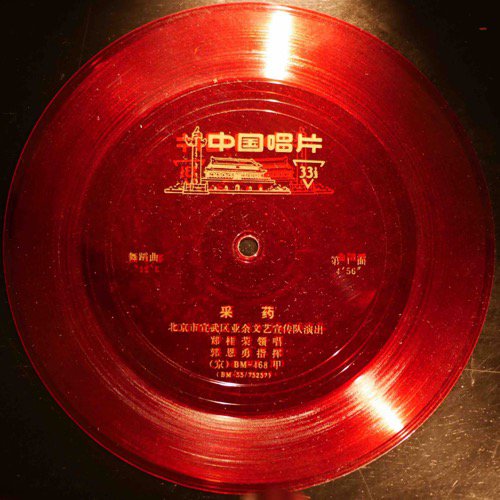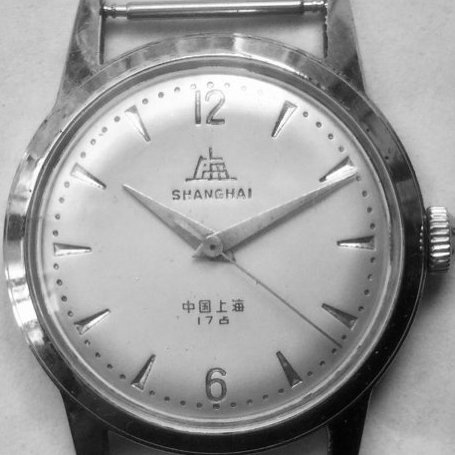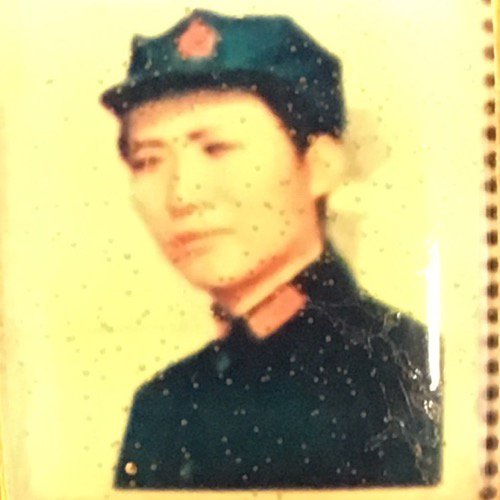Helen Wang, The British Museum & Felix Boecking, University of Edinburgh
Summary
In the early twentieth century, when the Communists gained territory, they set up revolutionary base areas (also known as soviets), and issued new coins and notes, using whatever expertise, supplies and technology were available. Like coins and banknotes all over the world, these played an important role in economic and financial life, and were also instrumental in conveying images of the new political authority. Since 1949, all regular banknotes in the People’s Republic of China have been issued by the People’s Bank of China, and the designs of the notes reflect the concerns of the Communist Party of China.Renminbi – the People’s Money
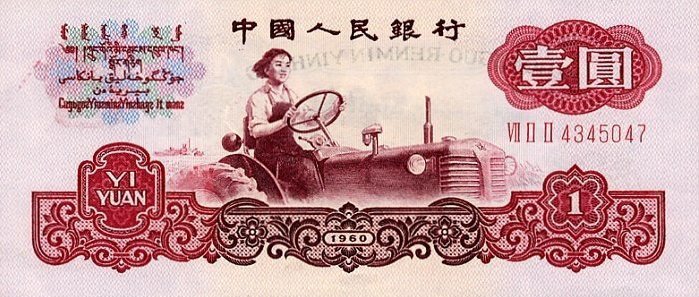
The money of the Mao era was the renminbi. This is still the name of the PRC's currency today - the ‘people’s money’, issued by the People’s Bank of China (renmin yinhang 人民银行). The ‘people’ (renmin 人民) refers to all the people of China. There are 55 different ethnic groups: the Han (Hanzu 汉族) being the majority, and the 54 others known as ethnic minorities (shaoshu minzu 少数民族).
While the term renminbi (人民币) deliberately establishes a contrast with the currency of the preceding Nationalist regime of Chiang Kai-shek, the term yuan (元) for the largest unit of the renminbi (which is divided into yuan, jiao 角, and fen 分) was retained from earlier currencies. Colloquially, the yuan is also known as kuai (块), literally ‘lump’ (of silver), which establishes a continuity with the silver-based currencies which China used formally until 1935 and informally until 1949.
Before the establishment of the PRC on 1 October 1949, the Communists had been gaining territories, which were known as revolutionary base areas (geming genjudi 革命根据地), and had issued money in those areas. People’s Bank of China notes with renminbi denominations were already being prepared and printed, and this explains why some of the first notes are dated 1948.
So far, there have been five series of renminbi: Series 1 (1948), Series 2 (1953), Series 3 (1960), Series 4 (1980), Series 5 (1999). Today, China is one of the biggest banknote producers in the world, printing notes for use in China and many other countries. At the same time, the Chinese government is promoting the use of digital currency, and many payments are now made digitally by phone, rather than by cash. The highest denomination of cash remains the 100-yuan note (this is to limit fraud). The 1-yuan note is to be discontinued in 2019. [See ⧉source: Renminbi, 1-yuan note, People’s Bank of China, 1969 (front) - female on tractor, also depicted to the left]
Disruption to economic planning during the Cultural Revolution
The early years of the Cultural Revolution caused considerable disruption to the Chinese urban economy. The political and intellectual atmosphere of the Cultural Revolution made it difficult, if not dangerous for Chinese statisticians to compile statistics.
A contemporary US estimate based on US government sources suggested that industrial production and Gross National Product fell during the first two years of the Cultural Revolution, 1966-1968, and had started to recover by 1969.1 The historical statistical series produced by the PRC’s government statistical office since the early 1980s suggest much the same thing; a decline in gross national product over the first two years of the Cultural Revolution, with a slow recovery starting in 1969. That decline is made up of a slow increase in the primary sector, and a decline in the secondary and tertiary sectors, which were largely urban-based.2
During the Cultural Revolution, money was only one requirement for a commercial transaction. The Cultural Revolution caused disruptions to both factories and economic planning, and many goods were in short supply. Furthermore, because of the shortages, many goods were also rationed.3
Therefore, in order for consumers to be able to purchase a particular item, that item had to exist in the market, and those wishing to purchase it often also had to present ration coupons, demonstrating that they were entitled to purchase it.
In today’s world, we think of the financial ability to purchase a good as they key determinant of a purchaser’s ability to buy that good. In a planned economy, like the economy of the PRC in the late 1960s, supply and entitlement to purchase that good were also serious factors. Does this make money less important? In 1971, two years after the 1-yuan banknote was issued, the PRC’s premier Zhou Enlai noted that ‘The amount of currency issued has also made a breakthrough. This is none too comfortable. Capitalism experiences economic crises, and even though we are fundamentally different from them, this is still not very comfortable.’4 Even though the PRC was a planned economy, the money supply clearly mattered greatly.
Designing a national currency
Continuing with the theme of people and unity, the name of the bank and the denominations are given in five different languages: Chinese characters and pinyin, Mongolian, Tibetan, Uyghur, and Zhuang. China was one of the first countries (perhaps the first) to introduce Braille on to its banknotes (from Series 4).
The decision to design a multilingual banknote in the early 1950s suggests that the party wanted the PRC to be seen as a multi-ethnic state. The first major statement to this effect was made by Deng Xiaoping, then responsible for Southwest China, an area which contained many ethnic minorities, in July 1950. Deng stated that the ‘People’s Republic of China is a multi-national country and only by ending this national estrangement and enlisting the concerted efforts of the various nationalities can we form a truly great, happy family of the Chinese nation’.5 The same point was made by Mao Zedong in one his most widely read speeches, ‘On the ten major relationships’. In this speech, Mao stated: ‘We must foster good relations between the Han nationality and the minority nationalities and strengthen the unity of all the nationalities in the common endeavour to build our great socialist motherland’.6 The political reality of the CCP’s policies on ethnic minorities makes that an interesting decision, just as it is interesting that the multilingual design has remained on the PRC’s banknotes to the present day.
The national emblem (which became official in 1950) has appeared on renminbi since the second series. Again, the design references both China and the international communist movement. It features Tian’anmen (from where Mao announced the establishment of the PRC), the five gold stars on a red background (as on the flag of the PRC), sheaves of wheat and rice and a cog-wheel beneath. The choice to include both agricultural and industrial items represents the fact that the PRC was seen as a state of peasants and workers, and is frequently found in Communist visual language in the PRC and beyond.
The design of the 1-yuan banknote with the female tractor driver offers us interesting questions about how the party wanted to portray China in the 1960s, when this design was created. It was first issued in 1969 and remained in circulation through the 1970s and 1980s, and was finally withdrawn in the mid-1990s. At this time, the majority of China’s population still lived in the countryside, so these images portrayed activities familiar to most users of Chinese bank notes. And yet, the two images on the note show the countryside as the leadership of the Chinese communist party-state wanted it to be, rather than as it actually was. Draft animals rather than tractors remained in widespread use in Chinese agriculture well into the reform period; and the economic disaster of the Great Leap Forward had decimated the livestock of China’s farmers. While banknotes primarily have an economic function, even in a socialist economy, they also serve the purpose of circulating political imagery selected by the government issuing them. [See ⧉source: Renminbi, 1-yuan note, People’s Bank of China, 1969 (back)]
Iconic design
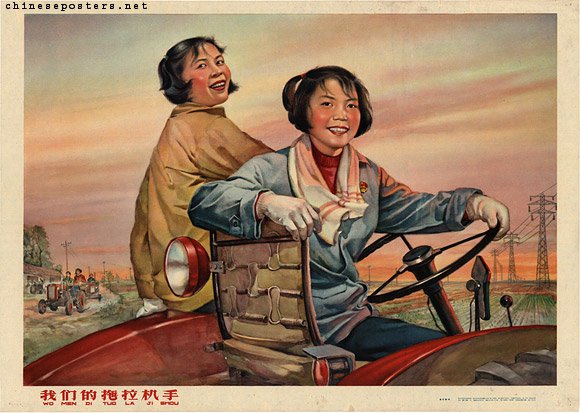
The 1-yuan note [see ⧉source: Renminbi, 1-yuan note, People’s Bank of China, 1969 (front) - female on tractor], issued in 1969, features one of the most iconic symbols of socialist modernity - the female tractor driver, seen in images and photographs from the USSR, and in China in the 1950s. Women were trained to use machinery, and some of the earliest female machine workers were tractor drivers, depicted as healthy young women, often in pristine white shirts, with a short haircut, and their hair blowing freely in the breeze. Throughout the world, women often appear on banknotes representing tradition, continuation, nurturing, production, harvest. The woman here conveys vividly the idea of liberation, in terms of gender equality, female emancipation and liberation, and also references the establishment of the People’s Republic of China on 1 October 1949, which is known in Chinese as ‘Liberation’ (jiefang 解放). The image in the note is based on a real woman, Liang Jun 梁军, who appeared on posters in the 1950s and on the new 1-yuan notes from 1962. Liang Jun qualified as China's first recorded female tractor driver in 1948, and only passed away earlier this month at the age of 90.7 This banknote was first issued in 1969. It is one of the most memorable designs of the Mao era, and was engraved by Wu Pengyue 吴彭越. On the back is a shepherd in the hills. [See ⧉source: Poster 'Our tractor drivers', also depicted to the right]
Security and authority
There is another aspect of the 1-yuan note which establishes a continuity with preceding currencies: besides being given in Arabic numerals and pinyin (the romanization system of Chinese characters adopted in the PRC in the early 1950s), the denomination of this note, 1 yuan, is also given in traditional Chinese characters (above the serial number). Even though the PRC undertook a project to reform China’s script and improve literacy rates by replacing complex characters with simplified ones in the 1950s, traditional, pre-script reform characters have continued to be used in commercial transactions to the present day, for the simple reason that a traditional character is more difficult to modify than a simplified one on an invoice, for instance. To give just one example: in simplified characters, the numeral one, yi, is written 一. In traditional script, it is written 壹. The simplified character could easily be altered to read two (er 二), three (san 三), four (si 四), five (wu 五), six (liu 六), ten (shi 十), 100 (bai 百), 1000 (qian 千), or 10,000 (wan 万). Using traditional characters in commercial transactions is therefore an age-old, yet highly effective security feature. The decision by the People’s Bank of China to continue using the traditional script on its currency even after the reform of the Chinese script, seen here a 1-fen coin issued in 2010, is a reference to this commercial practice. [See ⧉source: 1-fen coin]
Two of the four receipts in this image show the use of the 壹 numeral as a safety feature in the way described above [See ⧉source: Four receipts from the late 1960s]. On the first receipt, you will see the Arabic numerals 180 next to the ¥ symbol. In the same line, the purchase price, ¥180, is written out in traditional numerals as 壹佰捌拾元〇. On the fourth receipt, you will see the Arabic numerals 110.00 as the sum of the three subtotals. In the line below, the purchase price is written out as 元壹佰壹拾〇.
Following the Chinese tradition, there are no signatures on the banknotes, but two printed red seals (hangzhang zhi yin 行長之章 Seal of the Governor of the Bank, and fu hangzhang yin 副行長章 Seal of the Deputy Governor of the Bank). The notes are issued by the People’s Bank of China, and the calligraphy for the bank’s name is in the hand of Dong Biwu 董必武 (1886-1975), a senior party official who served as the director of the Finance and Economic Council of the State Council in the early PRC. Providing a beautiful handwritten inscription was a traditional art of statesmen – Mao’s calligraphy was visible everywhere. [See ⧉source: Graphic showing how to read a 1-yuan note]
Mao’s portrait on banknotes
Although Mao’s portrait was ubiquitous during the Mao era, it did not appear on banknotes or coins during the Cultural Revolution.8 Designs for banknotes featuring Mao were produced, but they were not approved for this purpose.9 Mao’s portrait did not appear on People’s Bank of China banknotes until after his death. The current series (Series 5) features Mao’s portrait on the front of each denomination, with his name and dates beneath (as per international banknote convention for historical figures). The 100-yuan note of 2015 was China’s first digitally engraved banknote, and was engraved by Ma Rong 马荣, one of the fourth generation of Chinese banknote engravers. [See ⧉source: The woman who digitally engraved 100-yuan banknotes and ⧉source: Ma Rong in Women of China]
Footnotes
Robert F. Dernberger, ‘Radical ideology and economic development in China: the Cultural Revolution and its impact on the economy’, Asian Survey vol. 12/12 (1972): 1060.
National Bureau of Statistics, China Statistical Yearbook 2000 (19/9) (Beijing: China Statistics Press, 2000), 53.
Roderick Macfarquhar and Michael Schoenhals, Mao’s last revolution (Cambridge, MA: Belknap, 2006), 375.
Ibid., 377.
Deng Xiaoping, ‘The Question of minority nationalities in the Southwest’, 21 July 1950.
Mao Zedong, ‘On the ten major relationships‘, 25 April 1956.
Zhou Huiying, ‘Pioneering woman farmer insists she’s driver of note’, China Daily USA, 11 February 2013 (http://usa.chinadaily.com.cn/china/2013-11/02/content_17075510.htm). Michael Bristow 'Liang Jun: China's first female tractor driver, and national icon dies', BBC News, 15 January 2020, (https://www.bbc.co.uk/news/world-asia-china-51116035).
Helen Wang, ‘Mao on Money’, East Asia Journal vol.1, no.2 (2004): 86-97.
Tim F. Liao and Cuntong Wang, 'The Changing Face of Money: Forging Collective Memory with Chinese Banknote Designs’, China Review vol. 18, no. 2, Special themed section: Frontiers and Ethnic Groups in China (May 2018): 87-120.
Sources
- ⧉ IMAGE
- 文 TEXT
- ▸ VIDEO
- ♪ AUDIO
- ⧉Image Money: Renminbi, 1-yuan note, People’s Bank of China, 1969 (front)
- ⧉Image Money: Renminbi, 1-yuan note, People’s Bank of China, 1969 (back)
- ⧉Image Money: Poster 'Our Tractor Drivers'
- ⧉Image Money: 1-fen coin
- ⧉Image Money: Four receipts from the late 1960s
- ▤Pdf Money: Graphic showing how to read the 1-yuan note
- ▸Video Money: The woman who digitally engraved 100-yuan banknotes
- 文Text Money: Ma Rong In Women Of China
Timeline
Further Reading
See the collection of Chinese paper money at the British Museum – Collection Online, or make an appointment to study them in the Dept of Coins and Medals.
For images of banknotes: Sinobanknote (http://www.sinobanknote.net).
'Tractor Girls’, on Chineseposters (https://chineseposters.net/themes/tractor-girls.php).
Barrass, Gordon S. The Art of Calligraphy in Modern China. London, British Museum Press, 2002.
Chen, Tina Mai. ‘Female Icons, Feminist Iconography? Socialist Rhetoric and Women's Agency in 1950s China’. Gender & History vol. 15, No. 2 (August 2003): 268-295.
Chen, Tina Mai. ‘Proletarian White and Working Bodies in Mao's China’. Positions: east asia cultural critique vol. 11, no. 2 (Fall 2003): 361-393.
Dernberger, Robert F. ‘Radical ideology and economic development in China: the Cultural Revolution and its impact on the economy'. Asian Survey 12/12 (1972): 1060.
Dreyer, June Teufel. China’s Forty Million: Minority Nationalities and National Integration in the People’s Republic of China. Cambridge: MA: Harvard University Press, 1976.
Du, Daisy Yan. ‘Socialist Modernity in the Wasteland: Changing Representations of the Female Tractor Driver in China, 1949–1964’, Modern Chinese Literature and Culture vol. 29, no.1 (Spring 2017): 55-94.
Perkins, Dwight H. ‘China’s economic policy and performance'. InThe Cambridge History of China, vol.15, edited by Roderick Macfarquhar, John K. Fairbank. Cambridge: Cambridge University Press, 1991: 475-539.
Kranister, W. (ed.), The Moneymakers International. Cambridge: Black Bear, 1989. On China see: 138-169.
Kraus, Richard Curt. The Party and the Arty in China: The New Politics of Culture. New York: Rowman & Littlefield Publishers, 2004.
Macfarquhar, Roderick and Michael Schoenhals. Mao’s Last Revolution. Cambridge, MA: Belknap, 2006.
Mullaney, Thomas S. Coming to Terms With the Nation: Ethnic Classification In Modern China. Oakland, CA: University of California Press, 2011.
Schwartz, Peter J. 'The Ideological Antecedents of the First-Series Renminbi Worker-and-Peasant Banknote or What Mao Tse-tung May Have Owed to Dziga Vertov’. Transcultural Studies, Jul 2014.
Wang, Helen. 'Ma Rong - engraver of Mao and monkeys' Chinese Money Matters (https://chinesemoneymatters.wordpress.com/2018/04/26/43-ma-rong-engraver-of-mao-and-monkeys/).


